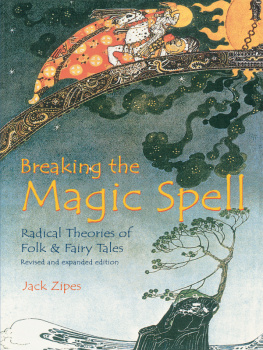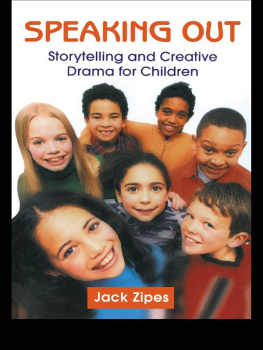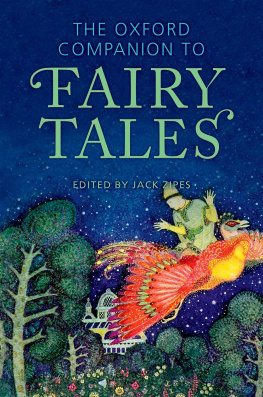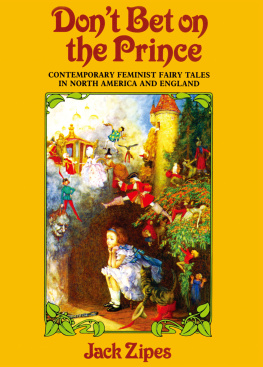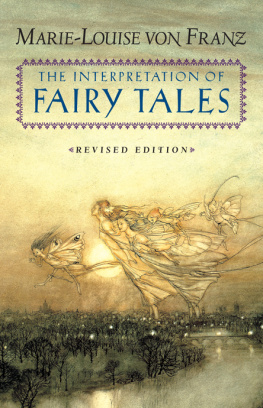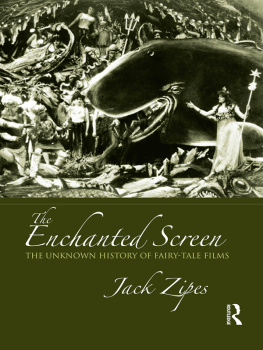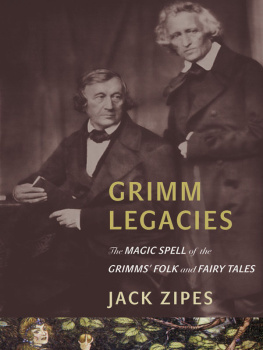Zipes - Fairy Tales and the Art of Subversion
Here you can read online Zipes - Fairy Tales and the Art of Subversion full text of the book (entire story) in english for free. Download pdf and epub, get meaning, cover and reviews about this ebook. City: London, year: 2011, publisher: Taylor and Francis;Routledge, genre: Home and family. Description of the work, (preface) as well as reviews are available. Best literature library LitArk.com created for fans of good reading and offers a wide selection of genres:
Romance novel
Science fiction
Adventure
Detective
Science
History
Home and family
Prose
Art
Politics
Computer
Non-fiction
Religion
Business
Children
Humor
Choose a favorite category and find really read worthwhile books. Enjoy immersion in the world of imagination, feel the emotions of the characters or learn something new for yourself, make an fascinating discovery.
- Book:Fairy Tales and the Art of Subversion
- Author:
- Publisher:Taylor and Francis;Routledge
- Genre:
- Year:2011
- City:London
- Rating:5 / 5
- Favourites:Add to favourites
- Your mark:
- 100
- 1
- 2
- 3
- 4
- 5
Fairy Tales and the Art of Subversion: summary, description and annotation
We offer to read an annotation, description, summary or preface (depends on what the author of the book "Fairy Tales and the Art of Subversion" wrote himself). If you haven't found the necessary information about the book — write in the comments, we will try to find it.
Zipes: author's other books
Who wrote Fairy Tales and the Art of Subversion? Find out the surname, the name of the author of the book and a list of all author's works by series.
Fairy Tales and the Art of Subversion — read online for free the complete book (whole text) full work
Below is the text of the book, divided by pages. System saving the place of the last page read, allows you to conveniently read the book "Fairy Tales and the Art of Subversion" online for free, without having to search again every time where you left off. Put a bookmark, and you can go to the page where you finished reading at any time.
Font size:
Interval:
Bookmark:
Fairy Tales and the Art of Subversion
... the most challenging study to appear on the subject for a considerable time.
TheTimes Educational Supplement
Tracing the development of literary fairy tales from Charles Perrault through the twentieth century, Zipes argues that they constitute a discourse on civilization,.... He avowedly seeks a political understanding of our notion of classicism and classical fairy tales. In doing so, he has produced a powerful work on the politics of culture.
The Journal of American Folklore

Routledge Classics contains the very best of Routledge publishing over the past century or so, books that have, by popular consent, become established as classics in their field. Drawing on a fantastic heritage of innovative writing published by Routledge and its associated imprints, this series makes available in attractive, affordable form some of the most important works of modern times.
For a complete list oftitles visit
www.routledge.com/classics
Jack
Zipes
Fairy Tales and the Art of
Subversion
The classical genre for children and the process of civilization
With a new introduction by the author

First published 1983 by Heinemann Educational Books Ltd.
Published in 1988 by Methuen, Inc.
Published 1991 by Routledge
Second edition published 2006 by Routledge
First published in Routledge Classics 2012
by Routledge
2 Park Square, Milton Park, Abingdon, Oxon OX14 4RN
Simultaneously published in the USA and Canada
by Routledge
711 Third Avenue, New York, NY 10017
Routledge is an imprint of the Taylor & Francis Group, an informa business
2006, 2012 Taylor and Francis Group, LLC
Introduction 2012 Jack Zipes
The right of Jack Zipes to be identified as author of this work has been asserted by him in accordance with sections 77 and 78 of the Copyright, Designs and Patents Act 1988.
All rights reserved. No part of this book may be reprinted or reproduced or utilised in any form or by any electronic, mechanical, or other means, now known or hereafter invented, including photocopying and recording, or in any information storage or retrieval system, without permission in writing from the publishers.
Trademark notice: Product or corporate names may be trademarks or registered trademarks, and are used only for identification and explanation without intent to infringe.
British Library Cataloguing in Publication Data
A catalogue record for this book is available from the British Library
Library of Congress Cataloging in Publication Data
Zipes, Jack, 1937
Fairy tales and the art of subversion : the classical genre for children and the process of civilization / Jack Zipes, with a new introduction by the author.2nd ed.
p. cm.(Routledge classics)
Includes bibliographical references and index.
1. Fairy talesHistory and criticism. 2. ChildrenBooks and reading.
3. Socialization. 4. Moral development. I. Title.
PN3437.Z56 2012
398.209dc23
2011019189
ISBN: 9780415610254 (pbk)
ISBN: 9780203805251 (ebk)
For the Feisty Subversives in My Life:
Carol, Hanna, Schoena
A CKNOWLEDGMENTS
This book was originally made possible by a Fulbright Grant from the International Exchange of Scholars, which allowed me to spend a year at the Johann Wolfgang Goethe Universitt in Frankfurt am Main, where I taught and conducted research in 1981 and 1982. In particular, I am indebted to Klaus Doderer, former director of the Institut fr Jugendbuchforschung, for the encouragement and assistance he provided me. During the course of my work I profited from various discussions with Thomas Elsaesser and from the suggestions of Roni Natov and Ralph Cohen, who published different and abbreviated drafts of in The Lion and the Unicorn and New Literary History. In addition, I should like to thank David Hill for his kind support and Caroline Lane and Betty Low for their fine editorial work in preparing this book for the first edition. In regard to the second revised edition, I am most grateful to Bill Germano for his advice and guidance and to Fred Veith for his valuable assistance. Finally, I want to express my gratitude to Sarah Blackmon for carefully taking charge and overseeing the production of this new edition and to Nicole Hirschman for her thorough copyediting of the manuscript.
I NTRODUCTION TO THE R OUTLEDGE C LASSICS E DITION
Fairy tales continue to pervade if not invade our lives throughout the world. They play an intricate role in acculturation, that is, in forming and reflecting the tastes, manners, and ideologies of members of a particular society. They have a powerful effect on how young and old behave and relate to their daily activities. Though seemingly universal, fairy tales serve a specific function in communicating the values and the various preoccupations of different nations. We have no idea exactly when fairy tales originated in oral cultures thousands of years ago, but we do know they were metaphorical stories that stemmed from basic human experiences and contained vital information that strengthened the common bonds of people living in small clans and tribes. Salient units of this information gradually formed the basis of narratives that enabled humans to learn about themselves and the worlds that they inhabited. These informative tales were not given titles. They were simply told to mark an occasion, to set an example, to warn about danger, to procure food, to explain what seemed inexplicable. People recounted stories in social contexts to communicate knowledge and experience. Though many ancient tales might seem to us to be magical, miraculous, fanciful, superstitious, or unreal, people believed them, and they were and are not much different from people today who believe in religions, miracles, cults, nations, and notions such as free democracies that have little basis in reality. In fact, religious and patriotic stories have more in common with fairy tales than we realize except that fairy tales tend to be secular and are not based on a prescriptive belief system or religious codes.
Fairy tales are predicated on a human disposition to social action to transform the world and make it more adaptable to human needs while we try to change and make ourselves fit for the world. Almost all fairy tales involve a quest. Therefore, their focus, whether the tale be oral, written, or cinematic, has always been on the struggle to find magical instruments, extraordinary technologies, or helpful people and animals that will enable protagonists to transform themselves and their environment and make the world more suitable for living in peace and contentment. Fairy tales begin with conflict because we all begin our lives with conflict. We are all misfit for the world, and somehow we must fit in, fit in with our environment and other people, and thus we must invent or find the means through communication to satisfy and resolve conflicting desires and instincts.
Every society has developed some sort of civilizing process to motivate its members to cooperate and co-exist in peaceful ways. Tales are motivators, and as they were told and retold over vast periods of times, they were woven into the texture of the civilizing process, retained in our memories, and assumed different forms for social purposes that determined the nature of their genre. Fairy tales, often called wonder or magic tales in oral cultures, were means of communication that afforded storytellers and listeners the opportunity to imagine and contemplate worlds more just and ideal than their realities. The tales afforded moral and ethical pleasure while not preaching or prescribing how to act.
Next pageFont size:
Interval:
Bookmark:
Similar books «Fairy Tales and the Art of Subversion»
Look at similar books to Fairy Tales and the Art of Subversion. We have selected literature similar in name and meaning in the hope of providing readers with more options to find new, interesting, not yet read works.
Discussion, reviews of the book Fairy Tales and the Art of Subversion and just readers' own opinions. Leave your comments, write what you think about the work, its meaning or the main characters. Specify what exactly you liked and what you didn't like, and why you think so.


